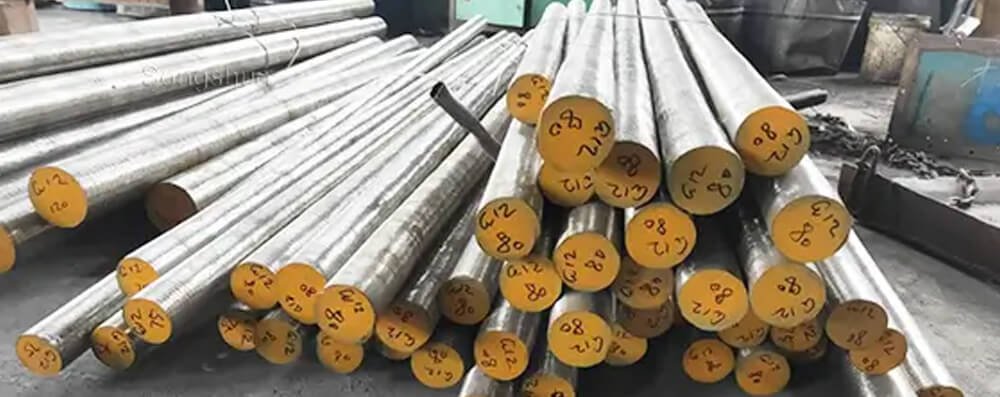Introduction
D3 tool steel, also known as HCHCR D3, is a high-carbon, high-chromium cold work tool steel that offers exceptional wear resistance, high compressive strength, and good dimensional stability during hardening and tempering. It belongs to the AISI D-series steels and is particularly well-suited for tools that require extreme wear resistance under severe abrasive conditions.
The steel is air-hardening with minimal distortion, making it ideal for producing precise tooling and dies.
Uses/Applications of the Grade:
D3 tool steel is extensively used for applications where high wear resistance and moderate toughness are necessary:
- Blanking and punching dies
- Forming dies
- Drawing dies
- Shear blades
- Gauges
- Plastic molds
- Wire drawing dies
- Cold cutting knives
- Industrial knives and slitters
Properties of the Grade:
- Exceptional Wear and Abrasion Resistance
- High Compressive Strength
- Good Dimensional Stability During Heat Treatment
- High Hardness (After Heat Treatment)
- Moderate Toughness
- Good Resistance to Tempering Softening
- Air Hardening with Minimal Distortion
Its high wear resistance makes it especially effective for long production runs where tool wear is a concern.
Chemical Composition:
| Element | Content (%) |
| Carbon (C) | 2.00 – 2.20 |
| Chromium (Cr) | 11.00 – 13.00 |
| Manganese (Mn) | 0.60 |
| Silicon (Si) | 0.60 |
| Molybdenum (Mo) | 0.80 (Optional) |
| Vanadium (V) | 0.10 – 0.30 |
| Phosphorus (P) | ≤ 0.03 |
| Sulfur (S) | ≤ 0.03 |
The high carbon and chromium levels contribute to superior hardness and wear resistance.
Mechanical Properties:
| Property | Typical Value |
| Hardness (Annealed) | ≤ 250 HB |
| Hardness (After Hardening) | 58–64 HRC |
| Compressive Strength | Approx. 2500 MPa |
| Tensile Strength (Ultimate) | ~ 1950 MPa (hardened) |
| Yield Strength | ~ 1500 MPa (hardened) |
| Elongation at Break | ~ 5% |
Note: Properties vary depending on final heat treatment and manufacturing conditions
Physical Properties:
| Property | Typical Value |
| Density | 7.7 – 7.8 g/cm³ |
| Modulus of Elasticity (E) | 210 GPa |
| Thermal Conductivity | ~24 W/m·K |
| Specific Heat Capacity | 460 J/kg·K |
| Coefficient of Thermal Expansion | ~11 × 10⁻⁶ /°C (20–100°C) |
Forging:
Forging Temperature Range: 950°C – 1100°C
Procedure:
- Preheat slowly to 700°C.
- Gradually increase to forging temperature.
- Do not forge below 900°C to prevent cracking.
- After forging, cool slowly in a furnace or insulated medium.
Post-forging annealing is necessary to remove internal stresses.
Heat Treatment:
-
Annealing:
- Heat uniformly to 850°C – 900°C.
- Hold for several hours.
- Cool slowly in the furnace to room temperature.
-
Hardening:
- Preheat in two steps: 400–500°C, then 800–850°C.
- Austenitize at 950°C – 980°C.
- Quench in still air or oil for high hardness requirements.
-
Tempering:
- Temper immediately after quenching.
- Typical tempering temperatures: 150°C – 300°C.
- Multiple tempering cycles are recommended to relieve stresses.
- Tempering reduces internal stresses and stabilizes hardness.
Dimensional Tolerances:
- Bright Bars: Generally h9 to h11 class of tolerance.
- Forged Bars/Plates: As per customer specifications and standards.
Because D3 is air-hardened, dimensional changes are minimal after heat treatment, making it ideal for precision tooling.
Machinability:
Relative Machinability: Approximately 40–50% (relative to 1% carbon steel).
Machining Tips:
- Machine in the annealed condition.
- Use high-quality carbide tooling for best results.
- Apply proper cooling methods to avoid thermal cracking.
Due to its high hardness and wear resistance, D3 is relatively difficult to machine once hardened.
Weldability:
D3 steel has poor weldability.
If welding is unavoidable:
- Preheat to 250°C – 300°C.
- Use appropriate filler material.
- Post-weld heat treatment (stress relieving and re-hardening) is strongly recommended.
Corrosion Resistance:
- Moderate corrosion resistance due to high chromium content.
- However, D3 is not classified as stainless steel and will corrode in wet or humid conditions if not properly protected.
- Protective coatings or oiling can prevent surface oxidation.
- Welding without proper pre- and post-heat treatment may lead to cracking.
Available Form:
D3 tool steel is typically available in the following forms:
- Bright Round Bars
- Forged Bars
- Flat Bars
- Plates
- Blocks
- Custom Profiles (upon request)
Standard and custom sizes are available from manufacturers and distributors.
Conclusion:
D3 tool steel is a premier choice for high-wear cold work applications. Its combination of high carbon and high chromium provides exceptional wear resistance, good dimensional stability, and excellent hardness. Although it has relatively low toughness and poor weldability, D3 excels in precision tooling, industrial knives, dies, and forming tools where long service life and minimal maintenance are critical. Proper handling during heat treatment and machining ensures that D3 offers maximum performance across a wide range of demanding industrial applications.
Related Products : D2, DB6, DIN 1.2714, DIN 1.2080, DIN 1.2379, DIN 1.2343, DIN 1.2344, EN31, H11, H13, OHNS, HCHCR, M2, P20+S, P20, P20+Ni, K310, Maps


